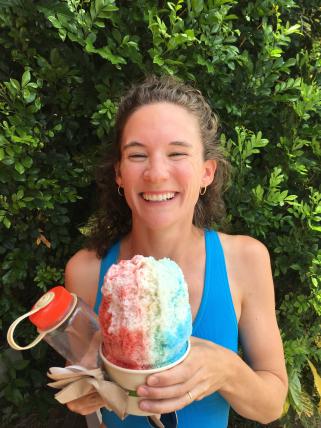By Katherine Owens
Reflecting on my time as a student in the applied mathematics department at the University of Washington I feel grateful for the ways that the community has inspired, equipped, and supported me. Starting at the University of Washington as a masters, student I was uncertain about whether graduate school was for me. My imposter syndrome stemmed from feeling underprepared and lacking a clear sense that math was my only possible calling. However, between dedicated instructors who were generous with office hours and brilliant, kind classmates who shared their expertise freely, I felt welcomed and included in the community both socially and intellectually. The following year I started as a PhD student, bonding with my cohort as we TA-ed calculus, completed problem sets, and prepared for qualifying exams, as well as connecting with my future advisors as I explored potential research projects.
I arrived at applied math through chronic indecision, by which I mean attempting to retain as many options as possible at each turning point in my education. Entering undergraduate, I knew that I wanted to pursue science, but I was hesitant to settle for one field. While taking an array of introductory science and math classes, I recognized that a common thread underlying the subjects was a reliance on key equations to draw meaning from data. Something finally clicked for me when I was taking linear algebra and learned about the PageRank algorithm at the center of Google’s search engine. Under the hood, math was running the world! I sensed that digging into mathematics would give me the flexibility to explore diverse and interesting questions across disciplines.
Between class projects and research at UW, I have been able to spend time doing just that. I studied topics like cellular networks, angiogenesis, natural selection, image classification, model discovery, and CAR T-cell therapy for cancer treatments—and those are just examples of putting my own pencil to paper or fingers to keyboard. There is so much more going on, across the department and across the university. One of my favorite parts of acting as a teaching assistant was consulting with students on their course projects for the mathematical methods in data analysis course and getting a small window into their field through my mathematical perspective.
The third and fourth years of my time in the PhD program proved particularly challenging for me, as I worked to develop the discipline to commit to one trajectory and see projects through to the end. When work moved online due to the SARS-CoV-2 pandemic, I had fewer chance check-ins with friends and colleagues in the department, so it was easy to feel isolated and stagnant. Luckily, I started an energizing new collaboration with Dr. Amin Rahman and I had patient advisors in Prof. Ivana Bozic and Prof. Nathan Kutz. Nathan continually reassured me that “wandering through the desert” was a necessary step towards finding meaningful results, and never let me lose faith that I would make it to the finish line.
Now that I have graduated, I am excited to be settling into my next role as a postdoctoral research fellow in the Vaccine and Infectious Disease Division at Fred Hutchinson Cancer Center. My new work focuses on understanding an important scientific question: how does SARS-CoV-2 evolve within the body? I get to work with an interdisciplinary mathematical modeling team that includes medical doctors, physicists, computer scientists and other applied mathematicians as well as experimental collaborators. I am looking forward to continuing to grow within and contribute to the vibrant Seattle area research community.
